Eating and Drinking with Lisbon’s Most Passionate Foodies
Article and photos by Lies Ouwerkerk
Senior Contributing Editor
1/17/2019 with resources updated 3/29/2024
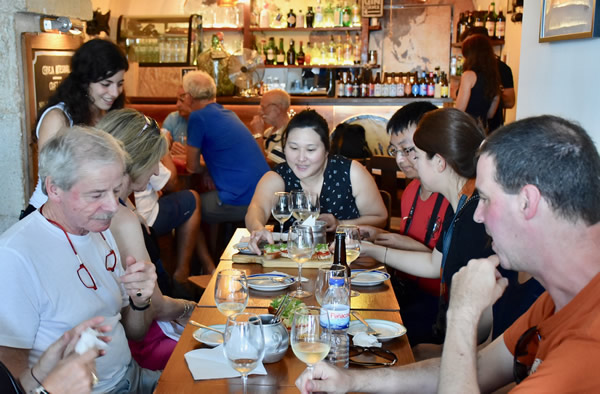 |
| Eating and drinking with Lisbon's most passionate epicureans. |
It had been ages since I visited Lisbon. Yet, vivid images of culinary delights, great wines, and super-congenial Lisboetas had always stayed with me.
So when I recently revisited the "City of Lights," I arranged some encounters with terrific local foodies who could introduce me again to the traditional cuisine of the Portuguese capital.
Fish and Seafood in Lisbon
In Portugal’s cuisine, fish and seafood are undeniably the main staples.
The country has not only Europe's highest fish consumption per capita but is also the world's largest consumer of bacalhau (cod). This fish has been part of the country's culture for centuries. In the Discovery Age (15th-18th centuries), ships armed with salt cod supplies could travel far, as the pickled fish would not spoil. Caught in the faraway North Atlantic, the salt cod could also easily endure the long journey home in an age when the refrigerator had not yet been invented: the dried fish needed to be soaked in water once ready for preparation and consumption.
Ways to prepare cod are numerous. The fish can be baked, grilled, roasted, (deep-fried, steamed, poached, or stewed. An all-time favorite in Lisbon is the Bacalhau à Brás, to which I was introduced by Dora, a graphic designer by day and fervent cook by night, in her cozy home in Alhos Vedros across the Tagus, a 20-minute ferry ride from downtown Lisbon.
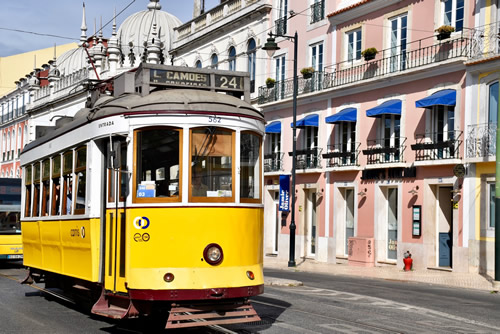 |
| Lisbon still has six historic tram lines in use. |
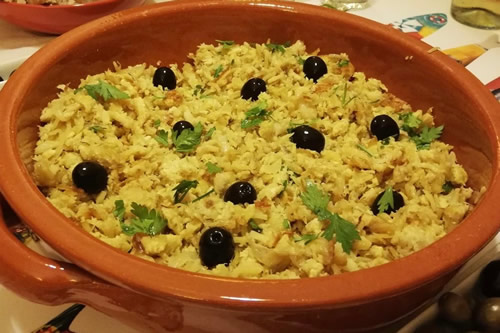 |
|
Bacalhau (codfish) a Bras.
|
In this particular bacalhau version, the fish is shredded and baked with onions and matchstick potatoes, bound with eggs, and topped with olives and parsley.
Another traditional dish preceded the delicious cod stew, caldo verde, a soup prepared with potatoes, julienned kale, garlic, and chouriço, another Lisbon favorite similar to the Spanish chorizo but less fat.
With Luísa, owner of the company "Mesa Luísa: From Market to Table", I ventured through the fresh fish section of the famous Mercado da Ribeira, before heading to her atmospheric cooking studio a few blocks away from the market. Inspired by her grandmother, whose house was often full of unexpected guests and therefore had to improvise in her kitchen regularly, Luisa decided on the spot — together with her fishmonger — to cook just-caught sole fillets. Traditional feijoada, a stew of onions, beans, carrots, bacon, and chouriço served with rice accompanied by the sole.
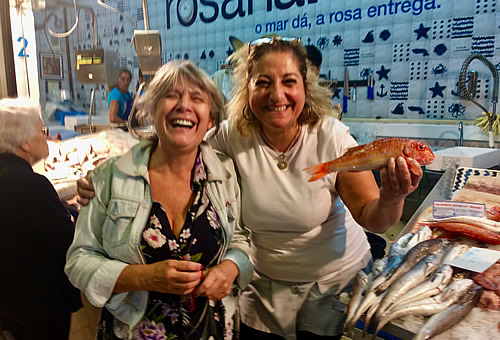 |
| Luisa and her fishmonger. |
Zé, also with his own company ("Chez Esteves: Home Made — Home Eaten — With Friends"), inquired a few days before dinner whether I preferred bacalhau, pork, or seafood. I opted for the seafood, and Zé conjured up an impressive shellfish stew called mariscada at his artsy apartment in the Avenida da Liberdade district, just a few steps from my rental studio. His place also included a grand patio, where we were welcomed with a superb, slightly fizzy vinho verde (literally: "green wine," though the wine is a white, and the name reportedly refers to it being a young wine, released after only several months after harvest).
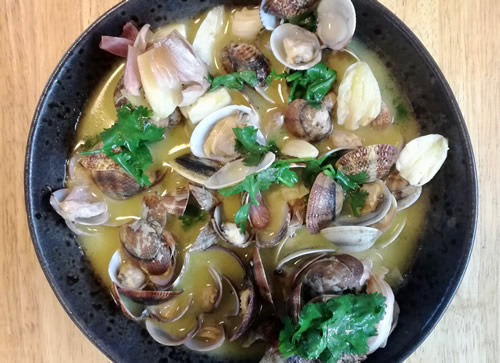 |
| Mariscada. |
Bacalhau is also a regular ingredient for petiscos, small snacks in some way similar to the Spanish tapas, but different in terms of spices and ingredients used. In Portugal, food is all about people and sharing, so nibbling on petiscos is an important part of Lisbon’s food culture.
When I joined Gonzalo — an IT specialist by trade and ambassador for the Portuguese media outlet WineSpots in his free time — for his tour "Wine Spots and Petiscos" through the Bairro Alto and Chiado areas, our first stop was a typical petisqueira, a tiny family restaurant. There we were offered, together with a glass of fresh vinho verde, one platter of cured ham and cheeses (another centuries-long tradition in Portugal), and another platter with the popular codfish balls called pataniscas, consisting of a deep-fried batter mixed with codfish morsels and parsley, and the similar pastéis de bacalhau, but with codfish and mashed potatoes.
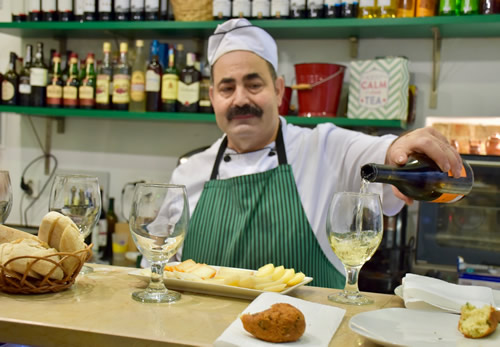 |
| Sharing petiscos and wine in a family-owned petisqueira. |
Portugal’s love affair with fish does not stop with cod. Lisbon is famous for its Santo António June festival that turns the city into “Sardine Central” — a sign that sardinhas, once a poor man’s food, are today very much in demand. Sardines are in season from March until October, and best to eat when they are fatty, from June onwards, preferably charcoal-grilled. For winter consumption, sales in rural areas, and export, they are tinned and preserved in oil, vinaigrette, or tomato sauce.
During my walking tour with "Treasures of Lisboa" through the historic and windy Alfama neighborhood, there were many opportunities to eat sardines in the little tascas and bistros we passed. With lots of information from guide Rita about the history of Lisbon in general, and all the fish, seafood, sausages, cheeses, hams, breads, and wines one gets to savor in particular, this is a great food & wine tour not to be missed. Come with an empty stomach!
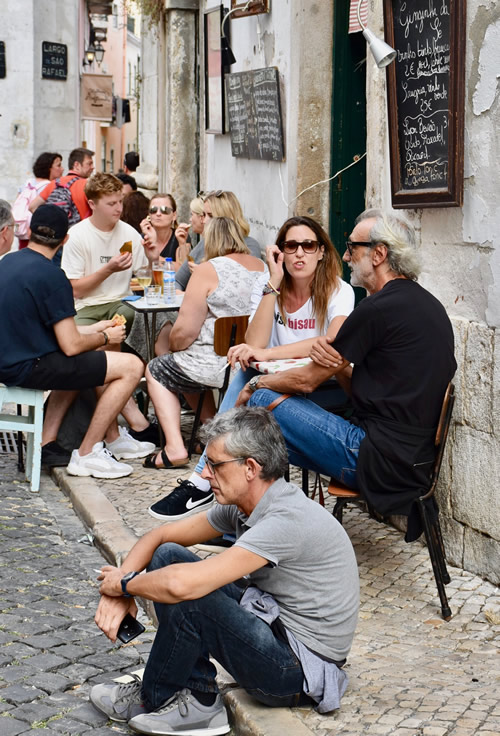 |
| Eating and drinking on the narrow Alfama district sidewalks. |
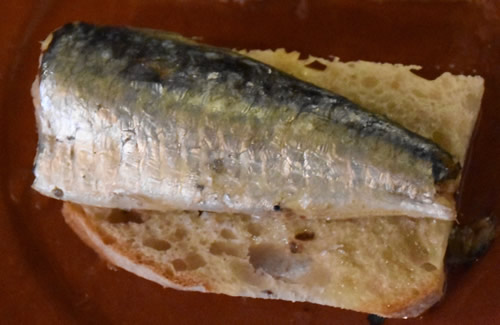 |
| A Portuguese sardine on bread. |
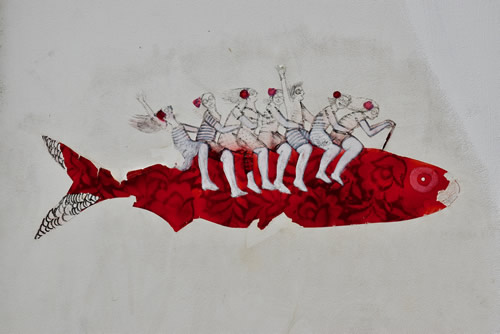 |
| During the yearly Sardinha festival, a competition is held to find the best sardine painting. |
Pastries and Desserts
At the end of our food tour, Rita brought us to a little bakery called "Fábrica do Pastel Feijão" for dessert. There, we tried their homemade specialty, pastel feijão, filled with a heavenly white bean and almond concoction. This is another proof that Portugal, where the sugar rush started in the 15th century with sugar from the island of Madeira, still takes its pastry culture very seriously.
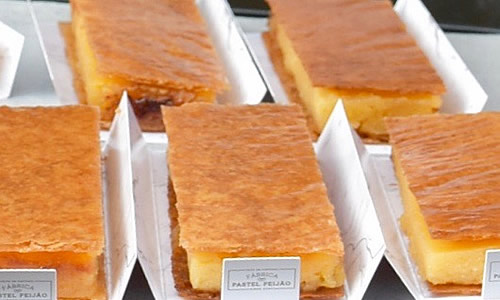 |
| Pastel feijão (bean pastry) at "Fábrica do Pastel Feijão". |
Indeed, Lisbon boasts hordes of pastry shops, and among the famous ones are recently opened pastelarias like "Manteigaria" and impressive old-school family-owned shops like "Versailles" (1922), "Confeitaria Nacional" (1829), "Pastelaria-Padaria São Roque" (1961), and "Antiga Confeitaria de Belém" (1837). The latter is the most frequented pastry shop in Portugal and is famous for its pastel de nata, commonly known as pastel de Belém.
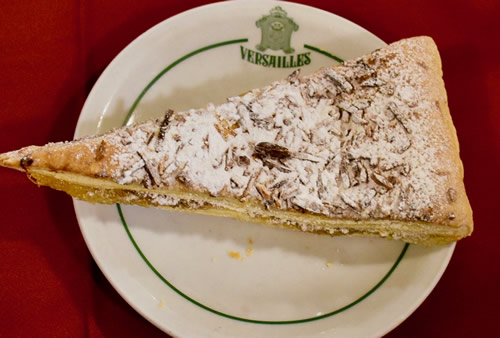 |
| Pumpkin-filled pastry topped with hazelnuts at "Versailles." |
 |
| Interior of "Versailles". |
 |
| Interior of "São Roque". |
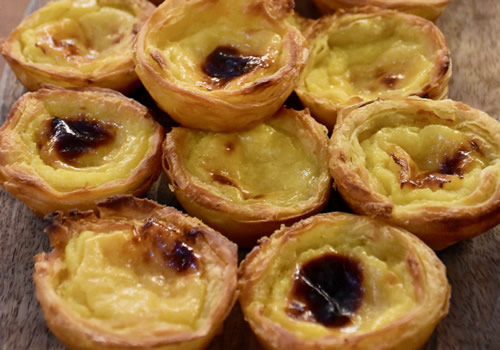 |
| Pasteís de nata. |
Dinners in my friends' homes also ended on a sweet note. Luísa prepared arroz doce, a Portuguese rice pudding usually eaten at Christmas. Zé was impressed with a queijo de figo, a cake made from figs and crushed almonds, and one of the few Portuguese desserts prepared without eggs. Dora even served two desserts: a baba de camelo or caramel mousse and the well-known salame de chocolate, in which the chocolate provides the marbled look of salami.
 |
| Salame de chocolate at Dora. |
“Food Pollinating” the Globe
Portugal made a considerable contribution to the culinary world in past centuries.
When Portuguese seafarers of the Discovery Age sailed the globe in search of new land, they lived in foreign countries and married natives, in that way fusing their Portuguese cuisine with that of their new lands. They also left “souvenirs” along their trade routes, introducing tempura-style frying to Japan, tea to England, African coffee to Brazil, Brazilian nuts to Africa, and African piri piri peppers to their Indian colonies Goa and Gujarat.
During my frequent wanderings through the city, I discovered various restaurants offering African-Portuguese foods, mainly from Portugal's ex-colonies in Africa, such as Angola, Mozambique, Cabo Verde, and São Tomé & Principe. Most of them could be found in the multicultural neighborhood of Mouraria, including "Cantinho do Aziz" and "Zambeze."
Brazilian hotspots were "Fogo de Chão," "Chimarrão," and "Oh!Brigadeiro," the latter a coffee shop with mouthwatering desserts, including the Brigadeiro chocolate truffles, typical Brazilian treats. These sweets were named after Brigadeiro Gomez, a politician whose presidential campaign in the 1940s was funded by the proceeds of the sales of the then-innovative truffles. Although the campaign did not achieve the desired outcome, the brigadeiros successfully lived in Brazil and Portugal.
Hanging out with Friendly and Welcoming Lisboetas
The common thread through all my Lisbon experiences was not only food and wine, however. What truly impressed me most was meeting and sharing a table with ordinary, super-welcoming locals who went out of their way to cook or show me the most delectable and traditional foods and gladly invited me into their private homes together with family members and friends.
Dora and her husband came to pick me up from the ferry. They had to rush me back when their dinner party became so animated that we nearly lost track of the last return ferry to Lisbon. Apart from the enormous work Dora had put into her copious meal, the open-arms welcome of the couple, their friends, and family — all mobilized for the occasion — was incredibly heartwarming.
Zé also invited other guests, and among them was a well-known local sommelier, who taught me tons of new information about Portuguese wines.
Joining me at Luísa's table were her son, a singer-songwriter, and his fiancée, a gorgeous French actress. I soon learned that the son was nobody less than Salvador Sobral, who had won the Eurovision Song Festival in 2017. When I later recounted the event to my other Portuguese hosts, they were green with envy that I had shared a meal with their national hero, who now tours the world along sold-out venues.
Locals’ Tips for Nightlife in Lisbon
Salvador's tip for Fado fans: instead of touristy Fado restaurants and clubs, head for more authentic places like "Tasca do Chico" and "Mesa dos Frades" or check out performances in "Fabrica do Braço de Prata." Here is one recent take on the "Top 6 Hidden Lisbon Restaurants Where Locals Eat."
Gonzalo's tips for cozy Portuguese wine bars (on top of the ones we visited such as "Taverna Rua Flores," "Pharmacia" with its small plates to share, "Le Consulat" in the old French consulate, "By the Wine" with its excellent pulled pork sandwich, and "Pensão Amor," previously a brothel): "BA Wine Bar do Bairro Alto," "Grapes and Bites," "Portologia," specializing in Port wines, and the small and intimate "Garrafeira Alfaia." The leading wines served in all these wine bars are from the Douro, Dão, Alentejo, Madeira, Setúbal (dessert wine), and Minho (vinho verde) regions.
Contact Info:
Lies Ouwerkerk is originally from Amsterdam, The Netherlands, and currently lives in Montreal, Canada. She was a columnist for The Sherbrooke Record and is now a freelance writer and photographer for various travel magazines.
|
